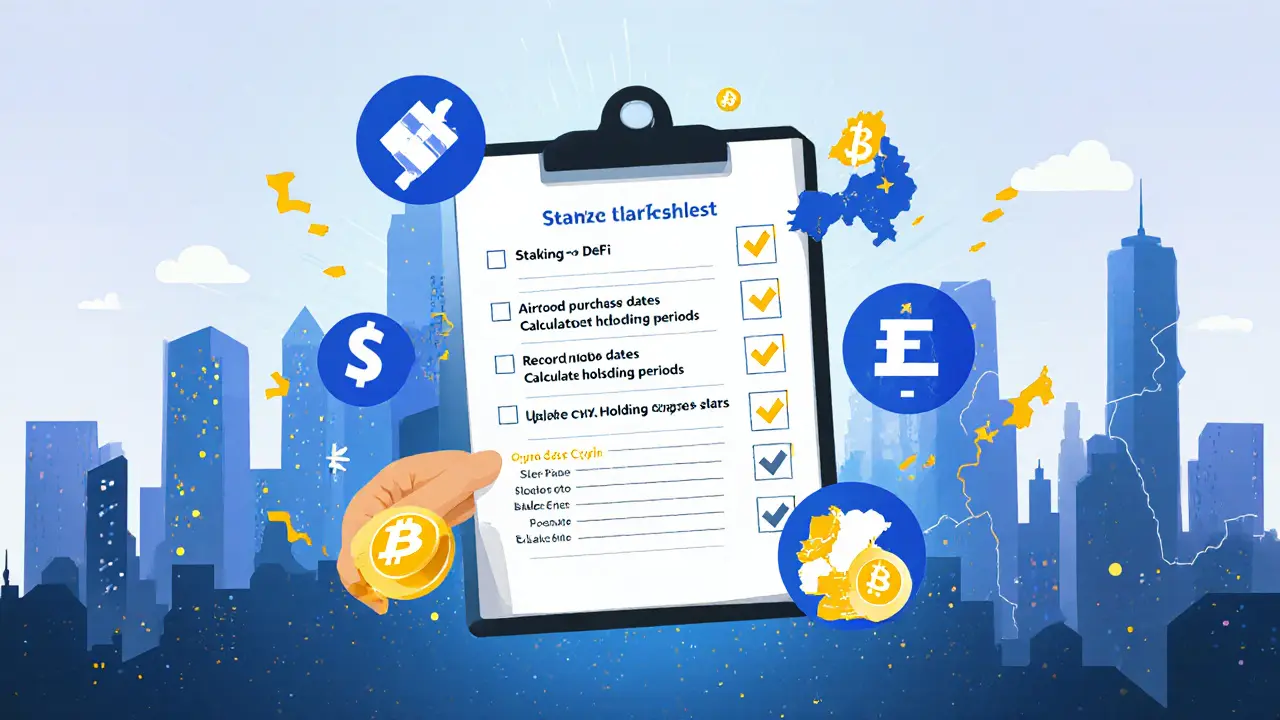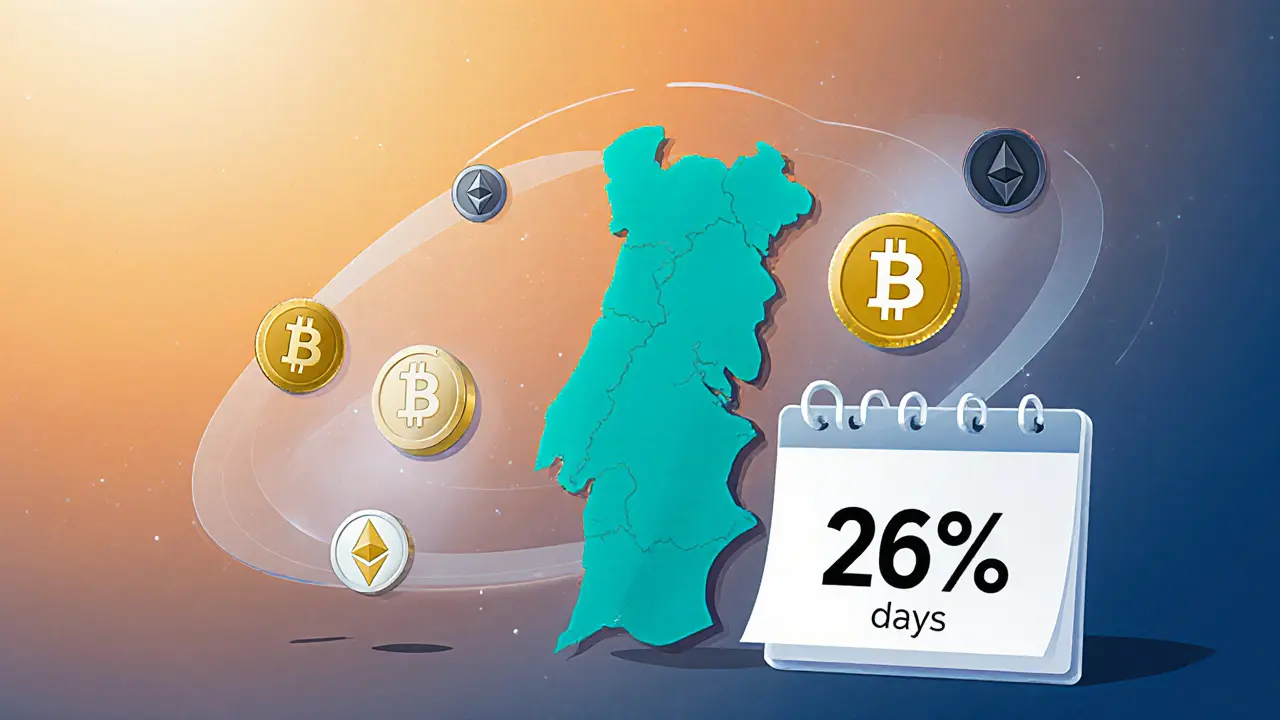Portugal Crypto Tax Calculator
Tax Overview
In Portugal, short-term crypto gains (held less than 365 days) are taxed at a flat 28%. Long-term gains (held 365+ days) are tax-free.
Important Note: Each purchase is treated as a separate lot. For precise calculations, FIFO (First In, First Out) is used for allocations.
Enter values and click "Calculate Tax Liability" to see your tax estimate.
Tax Comparison
Compare your potential tax outcomes:
- Short-term (< 365 days): Flat 28% tax rate
- Long-term (≥ 365 days): No tax
When you hear “Portugal is a crypto haven,” you probably picture zero tax on every trade. Since 2023 that picture has a twist: Portugal’s 28% short‑term cryptocurrency capital gains tax is a flat rate applied to profits from crypto sold within a year. The rule splits the market into two camps - short‑term speculators who now owe 28%, and long‑term HODLers who stay tax‑free. Below you’ll find everything a trader, digital nomad, or tax‑aware investor needs to navigate the new regime.
Key Takeaways
- Crypto sold<365days after purchase is taxed at a flat 28%.
- Holding crypto for ≥365days keeps the gain completely tax‑free.
- Taxpayers can either apply the flat 28% or add crypto gains to total income and be taxed under Portugal’s progressive brackets.
- Staking, lending, and DeFi rewards are also subject to the 28% rate unless you qualify as a professional trader.
- Reporting is done through the Portal das Finanças using AnexoG (capital gains) and AnexoE (passive crypto income).
How the 28% Rate Works
The tax applies to any “disposal” of a crypto asset - that means selling for fiat, swapping crypto‑to‑crypto, or converting to a stablecoin. If the holding period is less than 365days, the profit is multiplied by 0.28 and added to your tax bill. For example, buying 1BTC at €20,000 and selling a month later for €25,000 yields a €5,000 gain. The tax owed is €5,000×28%=€1,400.
Long‑term holdings (>365days) remain exempt, preserving Portugal’s appeal for investors who adopt a buy‑and‑hold strategy. The distinction is strict: the clock starts on the day you acquire the asset and stops on the day you dispose of it, regardless of how many partial sales you make.
Holding‑Period Rules and Edge Cases
Determining the exact holding period can be tricky when you use dollar‑cost averaging (DCA). Portuguese tax law treats each purchase as a separate lot. If you bought 0.5BTC on Jan1 and another 0.5BTC on Mar1, and then sold 0.6BTC on Apr1, you must allocate the sold units to the oldest lots first (FIFO). The portion coming from the Jan1 lot is short‑term, while the remainder may be long‑term.
Crypto‑to‑crypto swaps are also disposals. Swapping 1ETH for 0.03BTC triggers a taxable event for the ETH portion. You must calculate the Euro value of the ETH on the swap date and compare it to its acquisition cost. The same 365‑day rule applies to each leg of the swap.
Interaction with Portugal’s Progressive Income Tax Brackets
Taxpayers have a choice: apply the flat 28% or roll the gain into total taxable income. Portugal’s 2024 brackets start at 13.25% and top out at 48% for income over €81,199. If your combined income (salary+crypto gains) pushes you into a higher bracket, you might pay more than 28%.
For most middle‑income earners, the flat rate is cheaper. High‑income individuals (annual income>€81k) should compare the flat 28% against the marginal rate they would face by aggregating the gain. The tax code forces anyone whose total income exceeds the top bracket to use the progressive calculation, preventing a loophole where rich traders could hide behind the flat rate.
Reporting Requirements - Portal das Finanças
All Portuguese residents file the Modelo3 annual return. Crypto‑related entries are split across annexes:
- AnexoG - capital gains. Here you list each short‑term disposal, the acquisition cost, the sale price in euros, and the resulting gain.
- AnexoE - passive crypto income (staking, lending, liquidity rewards). The same 28% flat rate applies.
- AnexoB - business income for professional traders. Profits are taxed under the progressive system (14.5%‑53%).
Submission is fully online via Portal das Finanças. Keep a CSV export of every transaction: date, asset, amount, euro value at acquisition, euro value at disposal, and holding period. The tax authority can request the raw blockchain data, so good record‑keeping is essential.

Other Crypto‑Derived Income: Staking, Lending, DeFi
Reward tokens earned from staking, liquidity provision, or lending platforms are considered “other income” and fall under the same 28% flat rate, unless you are classified as a professional trader. The tax point is the day you receive the reward, not when you later sell it. For instance, earning 0.01BTC as a staking reward on July15 is taxed on the euro value of that 0.01BTC on that date.
Professional traders - defined by frequency, volume, and whether crypto activity is their main livelihood - must report those earnings under AnexoB, where the progressive rates apply. The tax authority looks at metrics such as average daily trades, use of leverage, and whether you keep dedicated trading software.
Non‑Habitual Residence (NHR) and Its Effect on Crypto Tax
The NHR regime, closed to new applicants in January2024, still benefits those who enrolled before then. NHR beneficiaries enjoy a flat 20% tax on Portuguese‑source income, which can be lower than the 28% short‑term rate for certain crypto activities. However, foreign‑source crypto gains may be exempt under the NHR, depending on the source country’s treaty. New residents after 2024 lose this advantage and must follow the standard rules described above.
How Portugal Stacks Up Against Other EU Countries
| Country | Short‑term rate | Long‑term exemption | Notes |
|---|---|---|---|
| Portugal | 28% flat | Yes, if held ≥365days | Flat rate aligns with other capital gains |
| Germany | Up to 45% (income tax) | Yes, if held ≥1year | Tax rate depends on total income |
| France | 30% flat (PFU) | No exemption | Same rate for short & long term |
| United Kingdom | Up to 20% CGT (higher‑rate) | No holding‑period exemption | Depends on asset classification |
| Spain | 19‑28% (savings income) | No exemption | Progressive within savings bracket |
Portugal remains attractive for long‑term investors because the 28% only hits short‑term trades, while Germany, France, and Spain tax all gains regardless of holding period. The UK’s capital gains tax caps at 20%, but it can climb to 45% if the activity is re‑characterised as income.
Practical Checklist for Portuguese Crypto Taxpayers
- Identify every purchase date and amount in euros.
- Classify each disposal as short‑term (<365days) or long‑term (≥365days).
- Calculate gains: sale price-acquisition cost.
- Choose between flat 28% or inclusion in total income.
- Record staking, lending, and airdrop rewards on the receipt date.
- Prepare CSV files for AnexoG (capital gains) and AnexoE (passive income).
- Upload everything via Portal das Finanças before the annual deadline (usually March31).
- If you think you qualify as a professional trader, consult a tax adviser to avoid mis‑classification.
Keeping a spreadsheet or using crypto‑tax software can automate steps 1‑5 and generate the required CSV for the portal.
Common Pitfalls & How to Avoid Them
- Mixing wallets - Consolidate data from all exchanges and hardware wallets; missing a small trade can skew the holding period.
- Ignoring airdrops - Treated as income on receipt, not capital gain later.
- Wrong lot selection - FIFO is default; if you use another method, you must prove it to the tax office.
- Assuming NHR applies - Only existing beneficiaries; new residents get standard rules.
- Late filing - Penalties start at 25% of owed tax plus daily interest.
Future Outlook
The EU’s MiCA framework, fully active since 2024, standardises reporting but leaves tax rates to member states. Portugal may refine the definition of “professional trader” to reduce ambiguity. Some industry insiders hint at a possible rate tweak if neighboring countries increase theirs dramatically, but the 28% flat rate is likely to stay for the near future.

FAQ
Do I pay any tax on crypto I hold for more than a year?
No. Gains from assets held 365days or longer are completely exempt from Portuguese tax, regardless of the amount.
Can I choose to apply the 28% flat rate even if I’m in a lower income bracket?
Yes. You may elect the flat rate for each short‑term gain. If your total income stays below the top bracket, the 28% is usually cheaper than the progressive rates.
How are staking rewards taxed?
Staking rewards are taxed at the 28% flat rate on the day you receive them, unless you are classified as a professional trader, in which case they follow the progressive business‑income rates.
What if I swap one crypto for another?
Every swap counts as a disposal. You must calculate the Euro value of the crypto you give up at the swap moment and treat the received crypto as a new acquisition.
Do I still need to file if I made no crypto trades in the year?
If you have no crypto activity, you don’t need to fill AnexoG or AnexoE, but you still file the regular Modelo3 for any other income.
Understanding Portugal’s 28% short‑term crypto tax is a matter of timing, record‑keeping, and choosing the right reporting path. Stay on top of the holding period, keep clean spreadsheets, and you’ll keep more of your digital gains.


13 Responses
Yo, that 28% bite feels like a crypto tax vampir 🧛♀️, lol.
Interesting rundown on the short‑term rule. For anyone juggling multiple buys, the FIFO approach can get messy fast, so keep a solid spreadsheet. It’s also worth noting that the flat 28% can actually be lower than your marginal bracket if you’re not in the top tax tier.
One might contemplate the philosophical weight of taxing short‑term speculation, yet the state persists in extracting value from rapid turnover. In the grand tapestry of nations, Portugal’s stance mirrors a disciplined fiscal ethos. Still, the global community watches, and the ripple effects are undeniable.
So now the “crypto haven” has a tax cliff-nice twist. Guess HODLers get to keep their beach vibes while day‑traders get the bill.
The introduction of a 28 percent levy on short‑term crypto gains in Portugal has sent ripples through the community, compelling investors to reassess their strategies. While the allure of a tax‑free haven still holds for those who can patiently hold assets beyond the 365‑day threshold, the new regime imposes a stark penalty on speculative flips. In practical terms, every disposal executed within a year now triggers a flat rate that eclipses the marginal income brackets for many middle‑class earners. Consequently, traders who previously enjoyed a pseudo‑tax‑exempt environment must now allocate resources to meticulous record‑keeping, ensuring each lot’s acquisition date is accurately logged. The FIFO method, though theoretically straightforward, can become labyrinthine when multiple purchases are interleaved across months. For example, a trader who acquired 1 BTC in January, another 0.5 BTC in June, and then sold 0.8 BTC in November must apportion the sold portion to the oldest lot first, potentially creating a mixed short‑ and long‑term tax profile. Such granularity not only burdens the individual but also invites scrutiny from the Portuguese tax authority, which now demands CSV‑style transaction histories. Moreover, the interplay between the flat 28 percent and the progressive personal income tax brackets adds another layer of complexity. If your total taxable income-including salary, rental yields, and crypto gains-exceeds €81,199, the law mandates that the higher marginal rates apply, effectively nullifying the flat‑rate benefit for high earners. Conversely, for those whose overall income remains modest, the 28 percent flat rate often proves cheaper than the escalating percentages of the progressive system. It is also crucial to recognize that staking rewards and liquidity provision earnings fall under the same flat regime, taxed at the moment of receipt rather than at eventual sale. Professional traders, defined by volume and frequency, are relegated to the business income annex where progressive rates ranging from 14.5 percent to 53 percent may apply. The Non‑Habitual Residence scheme, although now closed to newcomers, still offers a 20 percent flat tax for legacy participants, potentially providing a marginally lower rate for certain crypto‑related activities. International investors must also be vigilant about double‑tax treaties, as foreign‑source crypto gains might be exempt under those agreements. Ultimately, the Portuguese tax landscape presents a bifurcated reality: long‑term HODLers enjoy a sanctuary, while short‑term opportunists face a decidedly less forgiving regime. Navigating this terrain demands both disciplined investment horizons and diligent compliance practices.
Short‑term trades? Just 28%-no rocket science.
Good to see the breakdown; keeps things clear for anyone just starting out.
One cannot overstate the elegance of a tax system that differentiates between fleeting speculation and genuine investment. The Portuguese model, by imposing a modest 28 percent on short‑term gains, preserves the integrity of capital markets while rewarding patience. Yet many still cling to the myth of a zero‑tax haven, oblivious to the nuanced reality.
Isn’t it obvious the government is just lining its pockets under the guise of “integrity”? They’ll slap any rate they want once they realize crypto is booming. The whole “modest” claim is a smokescreen for deeper fiscal control.
Ah, the classic beach‑vs‑bill dichotomy-always a crowd‑pleaser. Let’s just hope the sand stays tax‑free.
If you’re new to the Portuguese system, start by exporting every transaction into a CSV with columns for date, asset, amount, acquisition euro value, disposal euro value, and holding period. Then run the FIFO allocation to separate short‑ and long‑term lots; many spreadsheet templates are already available online. Remember to file Anexo G for capital gains and Anexo E for staking rewards, attaching the CSV as supporting documentation. Lastly, double‑check whether the flat 28 percent or the progressive brackets give you a lower liability based on your total income.
Honestly, the CSV method is the only sane way-manual calculations will just drive you insane. Also, the flat rate is a trap for the unaware; you’ll often pay more by not considering your marginal bracket. Keep your eyes on the total income figure, not just the crypto slice.
🤷♂️ Taxes, huh?